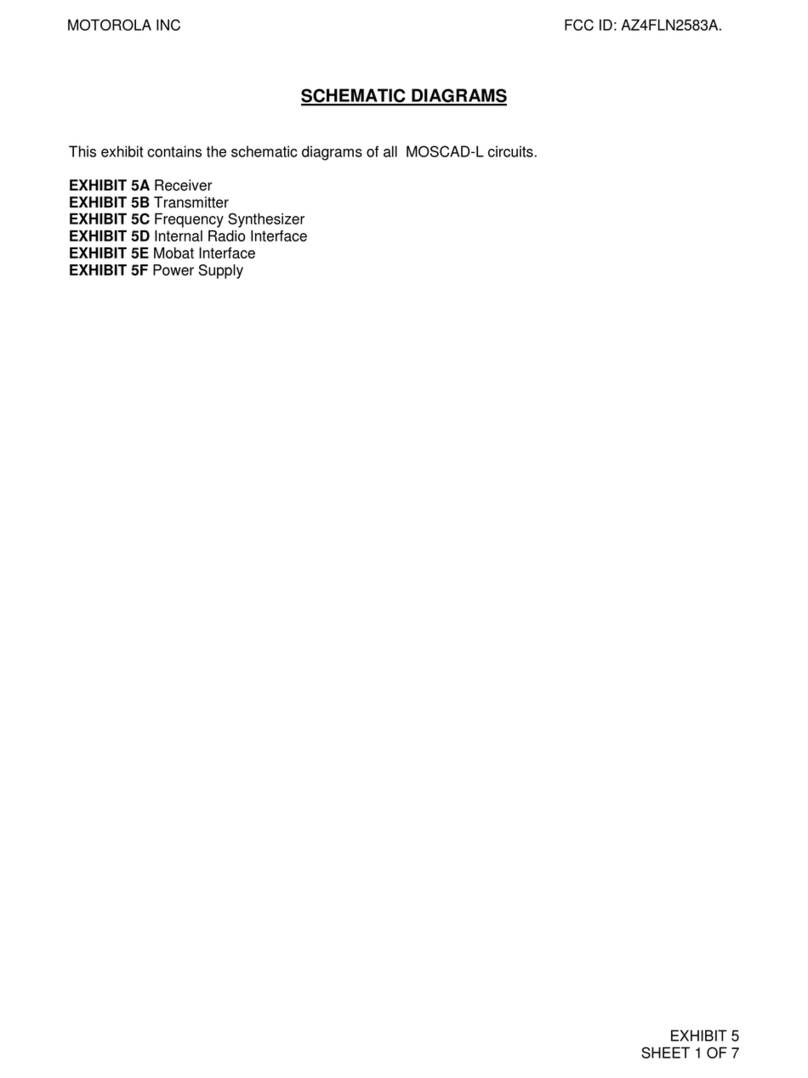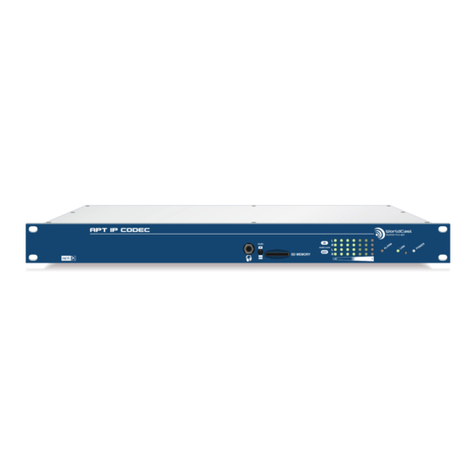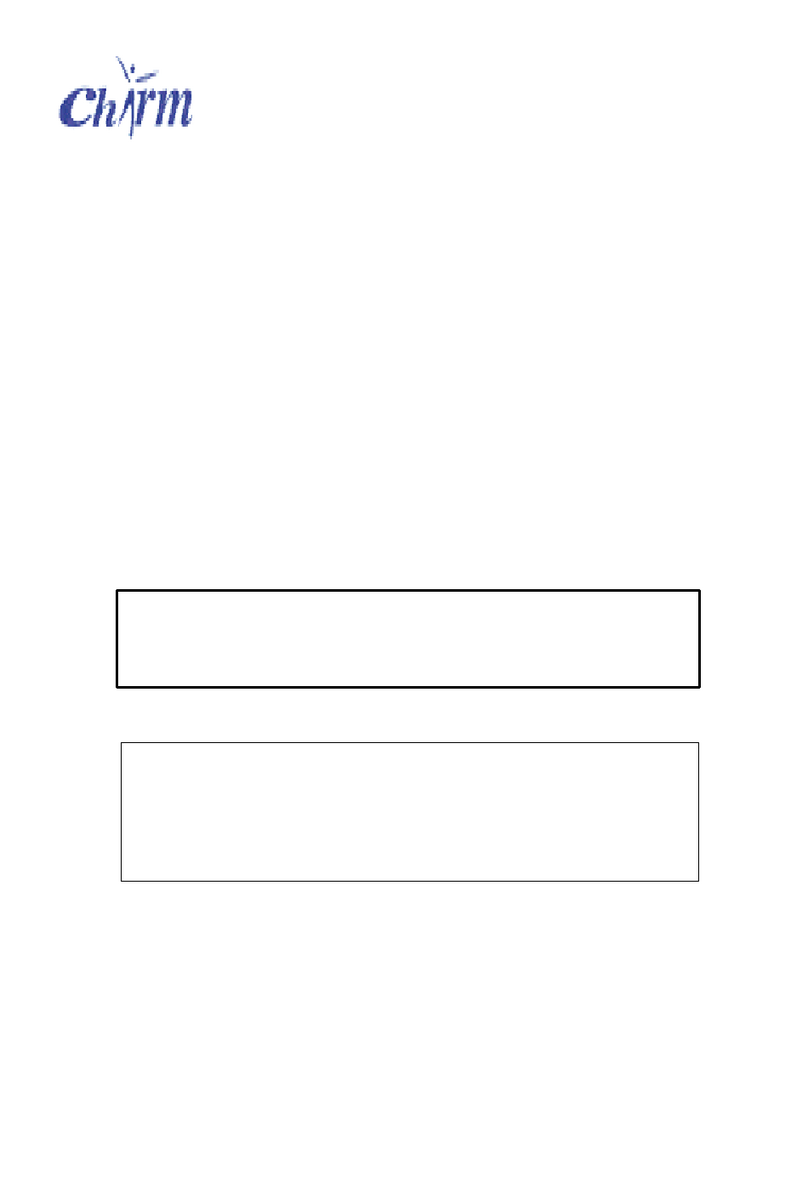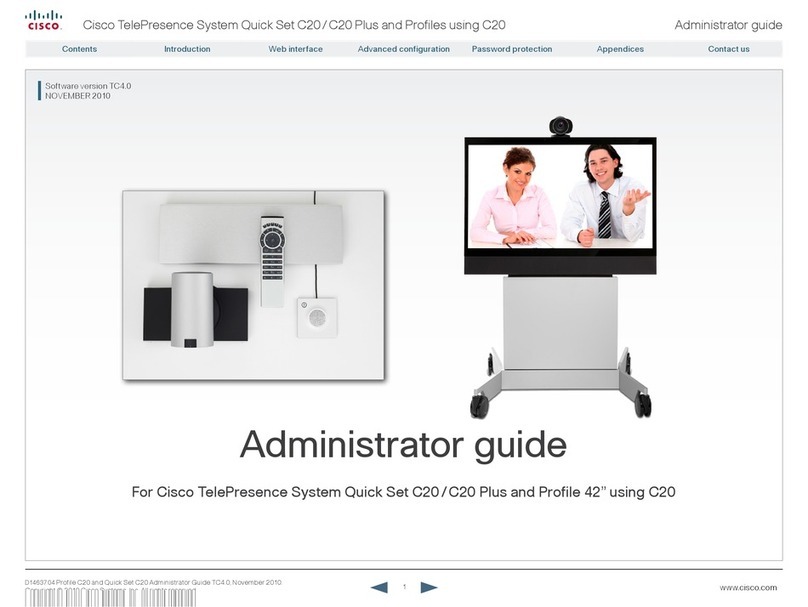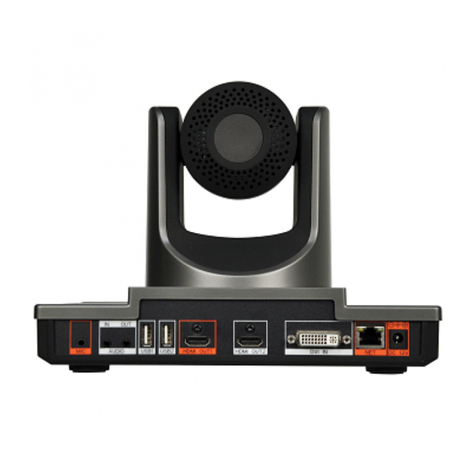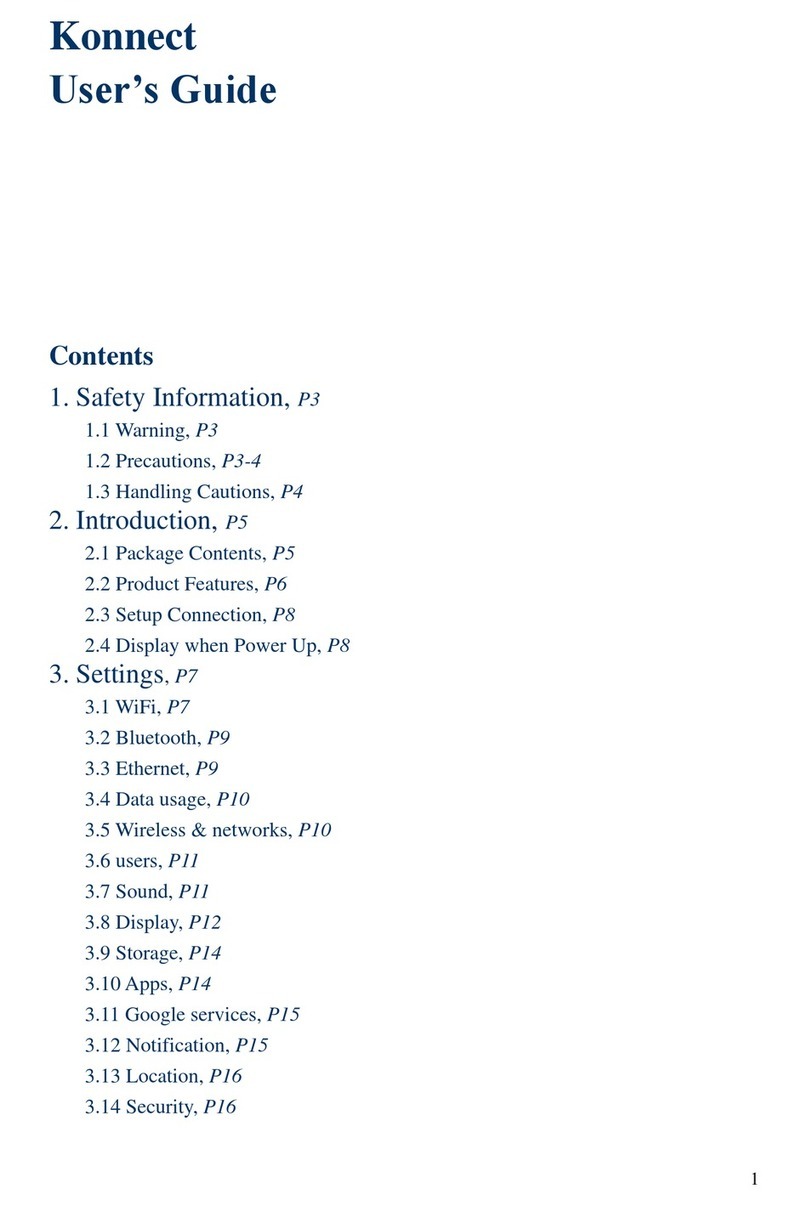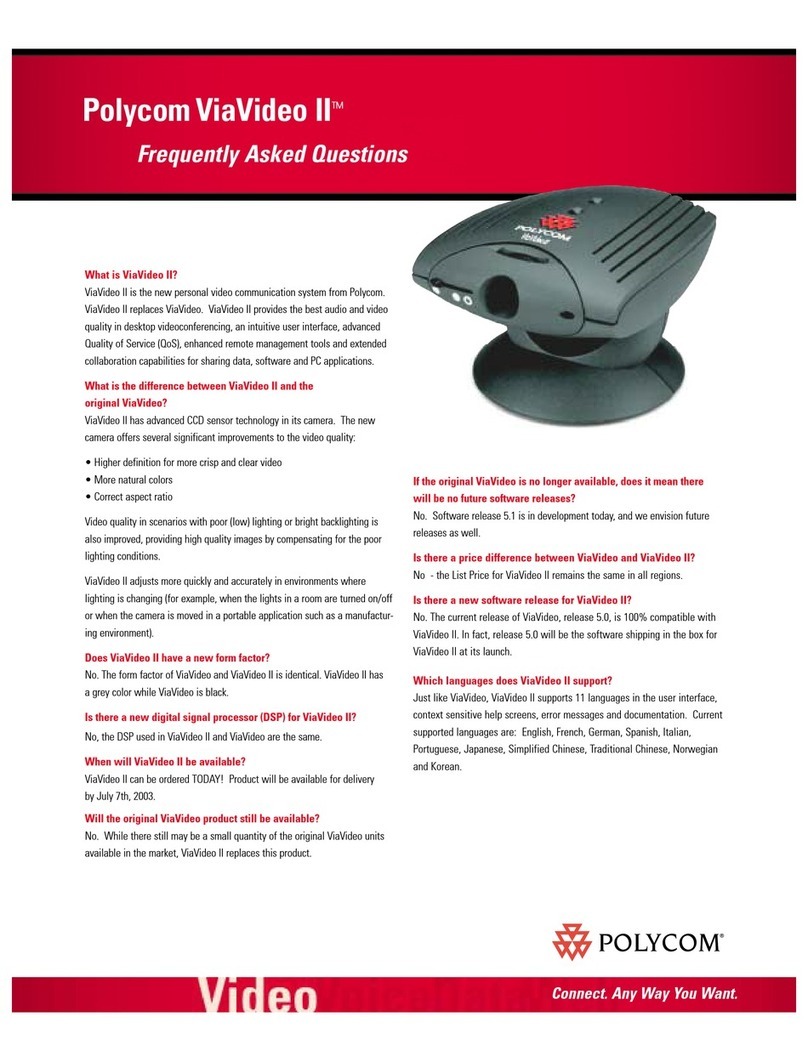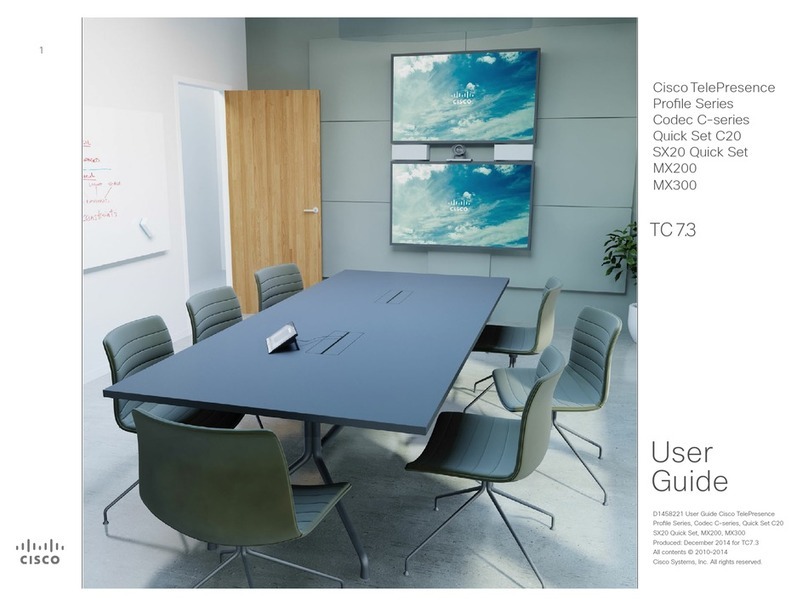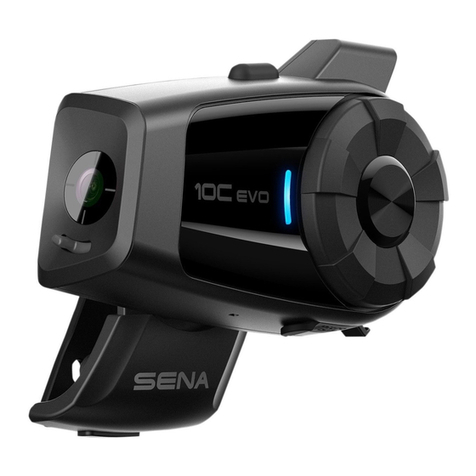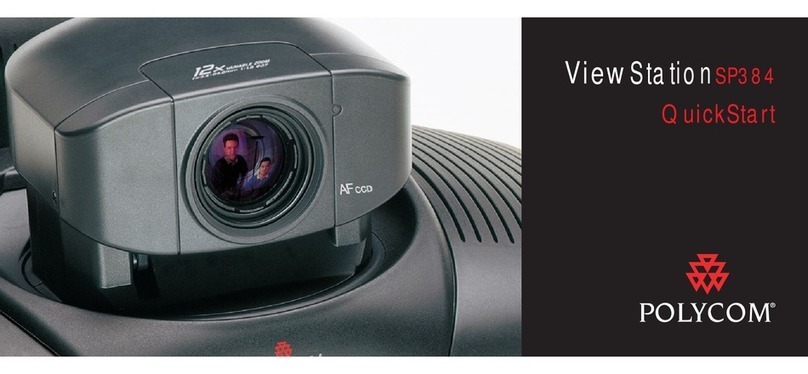Crystal CS4231A User manual

Features
•Windows Sound SystemTM
Compatible Codec
•ADPCM Compression/Decompression
•Extensive Software Support
•MPC Level 2 Compatible Mixer
•Dual DMA Registers support Full
Duplex Operation
•On-Chip FIFOs for higher performance
•Selectable Serial Audio Data Port
•Pin Compatible with CS4231/CS4248
General Description
The CS4231A includes stereo 16-bit audio converters
and complete on-chip filtering for record and playback
of 16-bit audio data. In addition, analog mixing and
programmable gain and attenuation are included to
provide a complete audio subsystem. A selectable se-
rial port can pass audio data to and from DSPs or
ASICs. Crystal-developed high-performance software
drivers for various operating systems are available that
support all the CS4231A features including full duplex
transfers. The CS4231A is a pin compatible upgrade to
the CS4231 and CS4248.
ORDERING INFORMATION:
CS4231A-KL 0 to 70°C 68-pin PLCC
CS4231A-KQ 0 to 70°C 100-pin TQFP
SEPT ’94
DS139PP2
1
Crystal Semiconductor Corporation
P.O. Box 17847, Austin, TX 78760
(512) 445-7222 Fax: (512) 445-7581
Parallel Interface, Multimedia Audio Codec
Semiconductor Corporation CS4231A
This document contains information for a new product. Crystal
Semiconductor reserves the right to modify this product withoutnotice.
Preliminary Product Information
Mute
Gain
Gain
Mux
LMIC
RMIC
LLINE
RLINE
LAUX1
RAUX1
LOUT
ROUT
RAUX2
LAUX2
Mute
AGND1 AGND2
DAC
Attenuate
20dB Gain
VREF VREFI
VREF
XTAL2I XTAL2O
Oscillators
LFILT RFILT
D<7:0>
A<1:0>
CS
WR
PDRQ
CDRQ
PDAK
CDAK
8
2
IRQ
DBDIR
DBEN
XCTL1
XCTL0
Parallel
Bus
Interface
PDWN
Mute
MIN
MOUT
Linear
µ
-law
A-law
ADPCM
Linear
µ
-law
A-law
ADPCM
DGND3/4/7/8DGND1 DGND2 XTAL1I XTAL1O
VD1
VD2
FIFO
16
Samples
VD3 VD4
16 Bit Timer
VA1 VA2
16-bit
A/D
16-bit
A/D
Mix
Gain
Mix
Gain
Mix
Gain
Mix
Gain
16-bit
D/A
16-bit
D/A
Optional
Dither
Loopback
Digital
Attenuation
RD
FIFO
16
Samples
SDOUT
SDIN
SCLK FSYNC
I4
I5
I3
I2
I26
I8
I18
I19
I26
I1
I0
I0
I1
I0
I1
I13
I10
I8
I8 or I28
I20,I21
I 16
I6
I7
TEST
Audio Data Serial Port
I16
Copyright
Crystal Semiconductor Corporation 1994
(All Rights Reserved)

TABLE OF CONTENTS:
CS4231A TECHNICAL SPECIFICATIONS..............3
GENERAL DESCRIPTION .......................................11
Enhanced Functions (MODE 2)..............................12
Mixer Attenuation Control on Line Input ..............12
ANALOG HARDWARE DESCRIPTION...................12
Analog Inputs..........................................................12
Line-Level Inputs plus MPC Mixer .......................13
Microphone Level Inputs......................................13
Mono Input with Attenuation and Mute................13
Analog Outputs .......................................................13
Mono Output with Mute Control ...........................14
Miscellaneous Analog Signals................................14
DIGITAL HARDWARE DESCRIPTION....................14
Parallel Data Interface ............................................14
FIFOs ......................................................................14
High Current Data Bus Drivers...............................15
PIO Registers Interface...........................................15
DMA Interface.........................................................15
Dual DMA Channel Mode ....................................16
Single DMA Channel (SDC) Mode.......................16
Serial Audio Data Port............................................16
Miscellaneous Signals.............................................18
Crystals/Clocks.....................................................18
Power Down - PDWN ..........................................19
DBEN/DBDIR .......................................................19
SOFTWARE DESCRIPTION ....................................19
Power-Down and Initialization.................................19
Calibration Modes...................................................20
Changing Sampling Rate........................................21
Changing Audio Data Formats ...............................21
Audio Data Formats................................................21
16-bit Signed ........................................................22
8-bit Unsigned ......................................................22
8-bit Companded..................................................22
ADPCM Compression/Decompression ................25
DMA Registers........................................................25
Playback DMA Registers......................................26
Capture DMA Registers .......................................26
Digital Loopback......................................................26
Timer Registers.......................................................27
Interrupts.................................................................27
Error Conditions......................................................27
CS4231A REGISTER MAPPING .............................28
Physical Mapping....................................................28
Index Address Register................ (R0)................29
Index Data Register ..................... (R1)................29
Status Register............................. (R2, RO)........29
Capture I/O Data Register ........... (R3, RO)........30
Playback I/O Data Register ......... (R3, WO) .......31
Left ADC Input Control................. (I0) .................31
Right ADC Input Control .............. (I1) .................31
Left Auxiliary #1 Input Control...... (I2) .................31
Right Auxiliary #1 Input Control... (I3) .................32
Left Auxiliary #2 Input Control...... (I4) .................32
Right Auxiliary #2 Input Control... (I5) .................32
Left DAC Output Control.............. (I6) .................32
Right DAC Output Control ........... (I7).................32
Fs and Playback Data Format..... (I8) .................33
Interface Configuration................. (I9) .................34
Pin Control ................................... (I10) ...............35
Error Status and Initialization....... (I11, RO)........35
MODE and ID............................... (I12) ...............36
Loopback Control......................... (I13) ...............36
Playback Upper Base .................. (I14) ...............36
Playback Lower Base .................. (I15) ...............36
Alternate Feature Enable I........... (I16) ...............37
Alternate Feature Enable II.......... (I17) ...............37
Left Line Input Control.................. (I18) ...............37
Right Line Input Control............... (I19) ...............40
Timer Lower Base........................ (I20) ...............40
Timer Upper Base........................ (I21) ...............40
Alternate Feature Enable III......... (I23) ...............40
Alternate Feature Status.............. (I24) ...............41
Version/ Chip ID........................... (I25) ...............41
Mono Input & Output Control....... (I26) ...............41
Capture Data Format ................... (I28) ...............42
Capture Upper Base .................... (I30) ...............42
Capture Lower Base .................... (I31) ...............42
GROUNDING AND LAYOUT ...................................43
COMPATIBILITY WITH AD1848..............................43
ADC/DAC FILTER RESPONSE PLOTS..................45
PIN DESCRIPTIONS ................................................47
PARAMETER DEFINITIONS....................................54
APPENDIX A ............................................................55
PACKAGE DIMENSION...........................................56
CDB4231/4248 Data Sheet......................................57
CS4231A
2DS139PP2

ANALOG CHARACTERISTICS (TA= 25 °C; VA1, VA2, VD1-VD4 = +5V;
Input Levels: Logic 0 = 0V, Logic 1 = VD1-VD4; 1 kHz Input Sine wave; Conversion Rate = 48 kHz;
Measurement Bandwidth is 10 Hz to 20 kHz, 16-bit linear coding.)
Parameter* Symbol Min Typ Max Units
Analog Input Characteristics
- Minimum Gain Setting (0dB); unless otherwise specified.
ADC Resolution (Note 1) 16 Bits
ADC Differential Nonlinearity (Note 1) ±0.5 LSB
Instantaneous Dynamic Range Line Inputs
(Note 2) Mic Inputs IDR 80
72 85
77 dB
dB
Total Harmonic Distortion Line Inputs
Mic Inputs THD 0.006
0.01 0.02
0.025 %
%
Signal-to-Intermodulation Distortion 90 dB
Interchannel Isolation Line to Line Inputs
Line to Mic Inputs
Line-to-AUX1
Line-to-AUX2
80
80
90
90
dB
dB
dB
dB
Interchannel Gain Mismatch Line Inputs
Mic Inputs 0.5
0.5 dB
dB
Programmable Input Gain Span Line Inputs 21.5 22.5 dB
Gain Step Size 1.3 1.5 1.7 dB
ADC Offset Error 0 dB gain 10 100 LSB
Full Scale Input Voltage: (MGE=1) MIC Inputs
(MGE=0) MIC Inputs
LINE, AUX1, AUX2, MIN Inputs
0.266
2.66
2.66
0.29
2.9
2.9
0.31
3.1
3.1
Vpp
Vpp
Vpp
Gain Drift 100 ppm/°C
Input Resistance (Note 1) 20 kΩ
Input Capacitance (Note 1) 15 pF
Notes: 1. This specification is guaranteed by characterization, no production testing.
2. MGE = 1 and a 10 µF capacitor on the VREF pin.
*Parameter definitions are given at the end of this data sheet.
Windows and Windows Sound System are registered trademarks of Microsoft Corporation.
Specifications are subject to change without notice.
CS4231A
DS139PP2 3

ANALOG CHARACTERISTICS (Continued)
Parameter* Symbol Min Typ Max Units
Analog Output Characteristics
- Minimum Attenuation (0dB); unless otherwise specified.
DAC Resolution 16 Bits
DAC Differential Nonlinearity (Note 1) ±0.5 LSB
Dynamic Range -Total All Outputs
-Instantaneous TDR
IDR 80 95
85 dB
dB
Total Harmonic Distortion (Note 3) THD 0.01 0.02 %
Signal-to-Intermodulation Distortion 85 dB
Interchannel Isolation Line Out (Note 3) 95 dB
Interchannel Gain Mismatch Line Out 0.1 0.5 dB
Voltage Reference Output 2.0 2.2 2.35 V
Voltage Reference Output Current (Note 4) 100 µA
DAC Programmable Attenuation Span 93 94.5 dB
DAC Attenuation Step Size 0 dB to -81 dB
-82.5 dB to -94.5 dB 1.3
1.0 1.5
1.5 1.7
2dB
dB
DAC Offset Voltage 1 10 mV
Full Scale Output Voltage: OLB = 0 (Notes 3, 5)
OLB = 1 OUT, MOUT 1.8
2.6 2.0
2.8 2.25
3.2 Vpp
Vpp
Gain Drift 100 ppm/°C
Deviation from Linear Phase (Note 1) 1 Degree
External Load Impedance 10 kΩ
Mute Attenuation (0 dB) 80 dB
Total Out-of-Band Energy 0.6xFs to 100 kHz (Note 1) -45 dB
Audible Out-of-Band Energy 0.6xFs to 22 kHz (Fs=8kHz) -60 dB
Power Supply
Power Supply Current Digital, Operating
Analog, Operating
Total
Digital, Power Down
Analog, Power Down
55
43
98
0.1
0.8
65
60
120
1
1
mA
mA
mA
mA
mA
Power Supply Rejection 1 kHz (Note 1) 40 dB
Notes: 3. 10 kΩ, 100 pF load.
4. DC current only. If dynamic loading exists, then the voltage reference output must be buffered
or the performance of ADCs and DACs will be degraded.
5. All mixer and output gain tables assume the output level bit, OLB, in indirect register 16 (I16) is set,
wherein the input and output full scale values are equal. When OLB=0, the output value is 3 dB
below the input value, given no gain or attenuation.
CS4231A
4DS139PP2

ABSOLUTE MAXIMUM RATINGS (AGND, DGND = 0V, all voltages with respect to 0V.)
Parameter Symbol Min Max Units
Power Supplies: Digital
Analog VD1-VD4
VA1,VA2 -0.3
-0.3 6.0
6.0 V
V
Input Current per Pin (Except Supply Pins) -10.0 +10.0 mA
Output Current per Pin (Except Supply Pins) -50 +50 mA
Analog Input Voltage -0.3 VA+0.3 V
Digital Input voltage -0.3 VD+0.3 V
Ambient Temperature (Power Applied) -55 +125 °C
Storage Temperature -65 +150 °C
Warning: Operation beyond these limits may result in permanent damage to the device.
Normal operation is not guaranteed at these extremes.
RECOMMENDED OPERATING CONDITIONS (AGND, DGND = 0V, all voltages with repect
to 0V.)
Parameter Symbol Min Typ Max Units
Power Supplies: Digital
Analog VD1-VD4
VA1,VA2 4.75
4.75 5.0
5.0 5.25
5.25 V
V
Operating Ambient Temperature TA02570°C
AUXILIARY INPUT MIXERS (TA = 25 °C; VA1, VA2, VD1-VD4 = +5V;
Input Levels: Logic 0 = 0V, Logic 1 = VD1-VD4; 1 kHz Input Sine wave)
Parameter Symbol Min Typ Max Units
Mixer Gain Range Span LINE, AUX1, AUX2 (Note 6)
MIN 45
42 46.5
45 dB
dB
Step Size LINE, AUX1, AUX2
MIN 1.3
2.3 1.5
3.0 1.7
3.4 dB
dB
Notes: 6. All mixer gain values assume OLB=1. If OLB=0, the analog output will be 3 dB below listed settings.
CS4231A
DS139PP2 5

DIGITAL CHARACTERISTICS (TA= 25°C; VA1, VA2, VD1-VD4 = 5V;
AGND1, AGND2, DGND1-DGND4, DGND7, DGND8 = 0V.)
Parameter Symbol Min Max Units
High-level Input Voltage Digital Inputs
XTAL1I, XTAL2I, PDWN VIH 2.0
VD-1.0 VD+0.3
VD+0.3 V
V
Low-level Input Voltage VIL -0.3 0.8 V
High-level Output Voltage: D<7:0> I0= -16.0 mA
All Others I0= -1.0 mA VOH 2.4
2.4 VD
VD V
V
Low-level Output Voltage: D<7:0> I0= 16.0 mA
All Others I0= 4.0 mA VOL 0.4
0.4 V
V
Input Leakage Current (Digital Inputs) -10 10 µA
Output Leakage Current (High-Z Digital Outputs) -10 10 µA
DIGITAL FILTER CHARACTERISTICS
Parameter Symbol Min Typ Max Units
Passband 0 0.40xFs Hz
Frequency Response -0.5 +0.2 dB
Passband Ripple (0-0.4xFs) ±0.1 dB
Transition Band 0.40xFs 0.60xFs Hz
Stop Band 0.60xFs Hz
Stop Band Rejection 74 dB
Group Delay 16- and 8-bit formats
ADPCM stereo format
ADPCM mono format
10/Fs
14/Fs
18/Fs
s
s
s
Group Delay Variation vs. Frequency ADCs
DACs 0.0
0.1/Fs µs
µs
CS4231A
6DS139PP2

TIMING PARAMETERS (TA= 25 °C; VA1, VA2, VD1-VD4 = +5V, outputs loaded with 30 pF;
Input Levels: Logic 0 = 0V, Logic 1 = VD1-VD4)
Parameter Symbol Min Max Units
WR or RD strobe width tSTW 90 ns
Data valid to WR rising edge (write cycle) tWDSU 22 ns
RD falling edge to data valid (read cycle) tRDDV 60 ns
CS setup to WR of RD falling edge tCSSU 10 ns
CS hold from WR or RD rising edge tCSHD 0ns
ADDR <> setup to RD or WR falling edge tADSU 22 ns
ADDR <> hold from WR or RD rising edge tADHD 10 ns
DAK inactive to WR or RD falling edge (DMA cycle
completion immediately followed by a non-DMA cycle) tSUDK1 60 ns
DAK active from WR or RD rising edge (non-DMA cycle
completion immediately followed by DMA cycle) tSUDK2 0ns
DAK setup to RD falling edge (DMA cycles)
DAK setup to WR falling edge tDKSUa
tDKSUb 25
25 ns
ns
Data hold from WR rising edge tDHD2 15 ns
DRQ hold from WR or RD falling edge
(assumes no more DMA cycles needed) tDRHD 025ns
Time between rising edge of WR or RD to next falling edge
of WR or RD tBWND 80 ns
Data hold from RD rising edge tDHD1 020ns
DAK hold from WR rising edge
DAK hold from RD rising edge tDKHDa
tDKHDb 25
25 ns
ns
DBEN or DBDIR active from WR or RD falling edge tDBDL 40 ns
PDWN pulse width low tPDWN 200 ns
Crystals, XTAL1I, XTAL2I frequency (Notes 1,7,8) 25.6 MHz
XTAL1I, XTAL2I high time (Notes 1,8) 18 ns
XTAL1I, XTAL2I low time (Notes 1,8) 18 ns
Sample frequency (Note 1) Fs 5.5 50 kHz
Serial Port Timing
SCLK frequency (Note 9) tSCLKW Fsx64 Hz
SCLK rising to SDOUT valid tPD1 30 ns
SCLK rising to FSYNC transition tPD2 -20 20 ns
SDIN valid to SCLK falling tS1 30 ns
SDIN hold after SCLK falling tH1 30 ns
Notes: 7. When only one crystal is used, it must be XTAL1. When using two crystals, the high frequency
crystal should be on XTAL1 which is designed for higher loop gains.
8. Sample frequency specifications must not be exceeded.
9. When SF1, 0 = 10, 32-bit mode, SCLK is active for the first 32 bit periods of the frame, and remains
low during the last 32 bit periods of the frame.
CS4231A
DS139PP2 7

tDRHD
tDBDL tDKHDb
tDHD1
tRDDV
tDKSUa
tSTW
CDRQ
CDAK
DBEN
D<7:0>
RD
DBDIR
tDBDL
8-Bit Mono DMA Read/Capture Cycle
SDIN
SDOUT
t
pd1
t
s1
t
h1
MSB, Left
SCLK
t
pd2
t
pd2
FSYNC
t
sckw
MSB, Left
t
pd2
FSYNC
SF1,0=01,10
SF1,0=00
Serial Port Timing
CS4231A
8DS139PP2

(high)
tDRHD
tDBDL
tDHD2
tWDSU
tDKSUb
tSTW
PDRQ
PDAK
D<7:0>
WR
DBDIR
tDKHDa
DBEN
8-Bit Mono DMA Write/Playback Cycle
RIGHT/HIGH
BYTE
LEFT/LOW
BYTE
tBWDN
D<7:0>
RD/ WR
CDRQ/PDRQ
CDAK/PDAK
8-Bit Stereo or 16-Bit Mono DMA Cycle
D<7:0>
LOW
BYTE
tBWDN
HIGH
BYTE
RD/
WR
CDRQ/
PDRQ
LEFT SAMPLE RIGHT SAMPLE
HIGH
BYTE
LOW
BYTE
CDAK/
PDAK
16-Bit Stereo or ADPCM DMA Cycle
CS4231A
DS139PP2 9

CDRQ/PDRQ
CDAK/PDAK
CS
DBEN
DBDIR
RD
D<7:0>
A<1:0>
tCSSU tCSHD
tDHD1
tRDDV
tADSU tADHD
tSUDK1 tSUDK2
tDBDL
tDBDL
I/O Read Cycle
CDRQ/PDRQ
CDAK/PDAK
CS
DBEN
DBDIR
WR
D<7:0>
A<1:0>
tCSSU tCSHD
tDHD2
tSUDK2
tADSU
tADHD
tWDSU
tSUDK1
tSTW
(high)
tDBDL
I/O Write Cycle
CS4231A
10 DS139PP2

CS4231A
74F245
DIR
G
D
A
T
A
D
A
T
A
D7
D0
DBEN
DBDIR
PDRQ
CDRQ
IRQ
CDAK
PDAK
63
62
14
12
57
11
13
Board Digital
Ground
34 37
AGND1,2
ISA
BUS
D7
D0
DRQ<X>
DRQ<Y>
DAK<X>
IRQ<Z>
Auxilary
Inputs
39
0.33
µ
F
LAUX1
42
0.33
µ
F
RAUX1
38
0.33
µ
F
LAUX2
30
0.33
µ
F
Line
Inputs LLINE
27
0.33
µ
F
RLINE
21
XTAL2I
22
XTAL2O
17
XTAL1I
18
XTAL1O
24.576MHz
16.9344MHz
33 pF
33 pF
33 pF
33 pF
29
0.33
µ
F
Microphone
Inputs LMIC
28
0.33
µ
FRMIC
33
0.1
µ
F
10
µ
FVREFI
This trace
must be
very short
32
0.47
µ
F
VREF
43
0.33
µ
F
RAUX2
46
0.33
µ
F
MIN XCTL0
XCTL1
56
58
SAI
SAO
IOWC
IORC
A1
A0
WR
RD 60
61
9
10
CS 59
SA 19:2
AEN
Address
Decode
18
1
µ
F
LOUT
40
47k
Ω
1
µ
F
ROUT
41
47k
Ω
47
1
µ
FMOUT
Board Analog
Ground
26
31
RFILT
LFILT
1000 pF
NPO
1000 pF
NPO
+
VA1VA2
15 7
1
35
1
µ
F
+
+5V
Supply
Ferrite Bead
0.1
µ
F
0.1
µ
F
2.0
Ω
19
0.1
µ
F
36
0.1
µ
F
+5V Analog (preferred)
If a separate +5V analog
supply is available, attach here
and remove the 2.0
Ω
resistor
1
µ
F+
VD2
1
µ
F
+
0.1
µ
F
VD1VD3VD4
TEST
55
DGND1,2DGND3, 4, 7, 8
2816 20 53 64
PDWN 23
DAK<Y>
PLCC
Pinout
()
AB
88
SCLK
FSYNC
SDOUT
SDIN
51
50
52
49
DSP
or
ASIC
47k
Ω
VD3/4
(Optional)
Figure 1. Recommended Connection Diagram
(See Figures 16 & 17 for Layout Recommendations)
CS4231A
DS139PP2 11

GENERAL DESCRIPTION
The CS4231A is a monolithic integrated circuit
that provides audio in personal computers or
other parallel interface environments. The func-
tions include stereo Analog-to-Digital and
Digital-to-Analog converters (ADCs and DACs),
analog mixing, anti-aliasing and reconstruction
filters, line and microphone level inputs, optional
A-Law / µ-Law coding, simultaneous capture
and playback and a parallel bus interface. Five
analog inputs are provided and three can be mul-
tiplexed to the ADC. The line input, two
auxiliary inputs and a mono input can be mixed
with the output of the DAC with full volume
control. Several data modes are supported in-
cluding 8- and 16-bit linear as well as 8-bit
companded, 4-bit ADPCM compressed, and 16-
bit Big Endian. The CS4231A is packaged in a
68-pin PLCC or a 100-pin TQFP.
Enhanced Functions (MODE 2)
The CS4231A’s initial state is labeled MODE 1
and forces the CS4231A to appear as a CS4248.
Enhanced functionality is provided by a second
mode on the CS4231A. To switch from
MODE 1 to MODE 2, the MODE2 bit should be
set to one in the MODE and ID register (I12).
When MODE 2 is selected, the bit IA4 in the
Index Address register (R0) will be decoded as a
valid index pointer, providing 16 additional reg-
isters and increased functionality over the
CS4248.
To reverse the procedure, clear the MODE2 bit
and the CS4231A will resume operation in
MODE 1. Since previous code writes a zero to
bit IA4 of the Index Address register (R0), the
CS4231A is backwards compatible with the
CS4248 and the AD1848.
Mixer Attenuation Control on Line Input
The CS4231A adds mixer attenuation control for
the LINE inputs which are then summed into the
output mixer. This fourth input to the mixer
completes the recommended mixer configuration
for MPC Level-2 compliance. The LINE mix
register provides 32 volume adjustments in 1.5
dB steps. In addition, there is a one bit mute
control.
The additional MODE 2 functions are:
1. Full-Duplex DMA support
2. A programmable timer
3. Mono output with mute control
4. Mono input with mixer volume control
5. ADPCM and Big Endian audio data formats
6. Independent selection of capture and
playback audio data formats
7. Selectable serial audio data port.
ANALOG HARDWARE DESCRIPTION
The analog hardware consists of an MPC
Level 2-compatible mixer (four stereo mix
sources), three line-level stereo inputs, a stereo
microphone input, a mono input, a mono output,
and a stereo line output. This section describes
the analog hardware needed to interface with
these pins.
Analog Inputs
The analog inputs consist of four stereo analog
inputs, and one mono input. As shown on this
data sheet cover, the input to the ADCs comes
from a multiplexer that selects between two ana-
log line-level inputs (LINE, AUX1), a
microphone level input (MIC), and the output
from the MPC-compatible mixer. The LINE and
AUX1 lines also feed the MPC mixer and in-
clude individual volume controls. Unused analog
inputs should be connected together and then
connected through a capacitor to analog ground.
CS4231A
12 DS139PP2

Line-Level Inputs plus MPC Mixer
The analog input interface is designed to accom-
modate four stereo inputs and one mono input.
Three of these sources are multiplexed to the
ADC. These inputs are: a stereo line-level input
(LINE), a stereo microphone input (MIC), and a
stereo auxiliary line-level input (AUX1). The
LINE and AUX1 inputs have a separate path,
with volume control, to the output analog mixer
which has the additional inputs of a stereo
AUX2 channel, a mono input channel, and the
output of the DACs. All audio inputs should be
capacitively coupled to the CS4231A.
Since some analog inputs can be as large as
2 VRMS, the circuit shown in Figure 2 can be
used to attenuate the analog input to 1 VRMS
which is the maximum voltage allowed for the
line-level inputs on the CS4231A.
Microphone Level Inputs
The microphone level inputs, LMIC and RMIC,
include a selectable + 20dB gain stage for inter-
facing to an external microphone. The 20 dB
gain block can be turned off to provide another
stereo line-level input. Figure 3 illustrates a sin-
gle-ended microphone input buffer with +18 dB
of gain that will support lower gain mics, and
should be placed as close to the input jack as
possible to minimize noise coupling.
Mono Input with Attenuation and Mute
The mono input, MIN, is useful for mixing the
output of the "beeper" (timer chip), provided in
all PCs, with the rest of the audio signals. The
attenuation control allows 16 levels in -3dB
steps. In addition, a mute control is provided.
The attenuator is a single channel block with the
resulting signal sent to the output mixer where it
is mixed with the left and right outputs. Figure 4
illustrates a typical input circuit for the Mono In.
Although this input is described for a low-qual-
ity beeper, the input is of the same high-quality
as all other analog inputs and may be used for
other purposes. At power-up, the MIN line is un-
muted (as is the mono out line) allowing the
initial beeps heard, when the computer is initial-
izing, to pass through.
Analog Outputs
The analog output section of the CS4231A pro-
vides a stereo line-level output. The other output
types (headphone and speaker) can be imple-
mented with external circuitry. LOUT and
ROUT outputs should be capacitively coupled to
external circuitry.
5.6 k
Ω
5.6 k
Ω
0.33
µ
F
0.33
µ
FR
L
5.6 k
Ω
5.6 k
Ω
Figure 2. Line Inputs
1
µ
F
+
560 pF
NPO
10
µ
F+
1.5 k
Ω
11 k
Ω
47 k
Ω
MC33078 or
MC33178
0.33
µ
F
VREF
LMIC
10
µ
F
+32
29
Figure 3. Left or Mono Microphone Input
2.7 nF
47 k
Ω
4.7 k
Ω
0.1
µ
F46 MIN
1
+5VA
(Low Noise)
Figure 4. Mono Input
CS4231A
DS139PP2 13

Mono Output with Mute Control
The mono output, MOUT, is a sum of the left
and right output channels, attenuated by 6dB to
prevent clipping at full scale. The mono out
channel can be used to drive the PC-internal
mono speaker using an appropriate drive circuit.
This approach allows the traditional PC-sounds
to be integrated with the rest of the audio sys-
tem. Figure 5 illustrates a typical speaker driver
circuit. The mute control is independent of the
line outputs allowing the mono channel to mute
the speaker without muting the line outputs. The
power-up default has MIN and MOUT enabled
to provide a pass-through for the beeps heard at
power-up.
Miscellaneous Analog Signals
The LFILT and RFILT pins must have a 1000 pF
NPO capacitor to analog ground. These capaci-
tors, along with an internal resistor, provide a
single-pole low-pass filter used at the inputs to
the ADCs. By placing these filters at the ADC
inputs, low-pass filters at each analog input pin
are avoided.
The VREFI pin is used to lower the noise of the
internal voltage reference. A 10µF and 0.1µF ca-
pacitor to analog ground should be connected
with a short wide trace to this pin. No other con-
nection should be made, since noise coupling
onto this pin can degrade the analog perform-
ance of the codec. Likewise, digital signals
should be kept away from VREFI for similar
reasons.
The VREF pin is typically 2.1 V and provides a
common mode signal for single-supply external
circuits. VREF only supports DC loads and
should be buffered if AC loading is needed. For
typical use, a 0.47 µF capacitor should be con-
nected to VREF. The signal-to-noise ratio of the
microphone inputs can be improved by increas-
ing the capacitance on VREF to 10 µF.
DIGITAL HARDWARE DESCRIPTION
The digital hardware consist of the data bus, ad-
dress bus, and control signals needed for the
parallel bus, as well as an interrupt and DMA
signals.
Parallel Data Interface
The 8-bit parallel port of the CS4231A provides
an interface which is compatible with most com-
puter peripheral busses. This parallel interface is
designed to operate on the Industry Standard Ar-
chitecture (ISA) bus, but the CS4231A will
easily interface with other buses such as EISA
and Microchannel. Two types of accesses can
occur via the parallel interface: Programmed I/O
(PIO) access, and DMA access.
There is no provision for the CS4231A to "hold
off" or extend a cycle occurring on the parallel
interface. Therefore, the internal architecture of
the CS4231A accepts asynchronous parallel bus
cycles without interfering with the flow of data
to or from the ADC and DAC sections.
FIFOs
The CS4231A contains 16-sample FIFOs in both
the playback and capture paths. The FIFOs are
0.1
µ
F
1
µ
F+
47
Ω
0.1
µ
F
47
Ω
+
1
µ
F12 7
38
5
6
416 k
Ω
470 pF
0.1
µ
F
Ferrite Bead
10 k
Ω
0.22
µ
F
47
MOUT
+5V
RESDRV
MC34119
Figure 5. Mono Output
CS4231A
14 DS139PP2

transparent and have no programming associated
with them.
When playback is enabled, the playback FIFO
continually requests data until the FIFO is full,
and then makes requests as positions inside the
FIFO are emptied, thereby keeping the playback
FIFO as full as possible. Thus when the system
cannot respond within a sample period, the FIFO
is emptied, avoiding a momentary loss of audio
data. If the FIFO runs out of data, the last valid
sample can be continuously output to the DACs
(if DACZ in I16 is set) which will eliminate
pops from occurring.
When capture is enabled, the capture FIFO tries
to continually stay empty by making requests
every sample period. Thus when the system can-
not respond within a sample period, the capture
FIFO starts filling thereby avoiding a loss of
data in the audio data stream.
High Current Data Bus Drivers
The CS4231A provides 16 mA drivers eliminat-
ing the need for off chip drivers in many cases.
If a full 24 mA drive is required, the appropriate
direction and driver select lines are provided.
The current drivers are provided for the data bus,
DMA request line, and the interrupt request line.
PIO Registers Interface
The first type of parallel bus access is pro-
grammed I/O (PIO) to the four control registers.
The control registers allow access to status,
audio data, and all indirect registers via the in-
dex registers. The RD and WR signals are used
to define the read and write cycles respectively.
The PIO register cycle is defined by the asser-
tion of the CS4231A CS signal while the DMA
acknowledge signals, CDAK and PDAK, are in-
active. For read cycles, the CS4231A will drive
data on the DATA lines while the host asserts the
RD strobe. Write cycles require the host to assert
data on the DATA lines and strobe the WR sig-
nal. The CS4231A will latch data into the PIO
register on the rising edge of the WR strobe. The
CS4231A CS signal should remain active until
after completion of the read or write cycle. I/O
cycles are the only type of cycle which can ac-
cess the internal control and status registers.
When reading or writing audio data via PIO, the
Status register (R2) indicates which byte of the
audio sample is ready. The Status register does
not have to be read after every byte; however,
once all bytes of a sample are transferred, the
Status register must be read before the next sam-
ple can be transferred.
The audio data interface typically uses DMA re-
quest/grant pins to transfer the digital audio data
between the CS4231A and the bus. The
CS4231A is responsible for asserting a request
signal whenever the CS4231A’s internal buffers
need updating. The logic interfaced with the
CS4231A responds with an acknowledge signal
and strobes data to and from the CS4231A, 8
bits at a time. The CS4231A keeps the request
pin active until the appropriate number of 8-bit
cycles have occurred to transfer one audio sam-
ple. Notice that different audio data types will
require a different number of 8-bit transfers.
DMA Interface
The second type of parallel bus cycle on the
CS4231A is a DMA transfer. DMA cycles are
distinguished from PIO register cycles by the as-
sertion by the CS4231A of a CDRQ (or PDRQ)
followed by an acknowledgment by the host by
the assertion of CDAK (or PDAK). While the
acknowledgment is received from the host, the
CS4231A assumes that any cycles occurring are
DMA cycles and ignores the addresses on the
address lines and the CS line.
The CS4231A may assert the DMA request sig-
nal at any time. Once asserted, the DMA request
will remain asserted until a DMA cycle occurs to
the CS4231A. Once the falling edge of the final
CS4231A
DS139PP2 15

WR or RD strobe of a full sample of a DMA
cycle occurs, the DMA request signal is negated
immediately. DMA transfers may be terminated
by resetting the PEN and/or CEN bits in the In-
terface Configuration register (I9), depending on
the DMA that is in progress (playback, capture,
or both). Termination of DMA transfers may
only happen between sample transfers on the
bus. If PDRQ and/or CDRQ goes active while
resetting PEN and/or CEN, the request must be
acknowledged (PDAK and/or CDAK) and a fi-
nal sample transfer completed. The CS4231A
supports up to two DMA channels.
Dual DMA Channel Mode
In dual DMA channel mode, playback and cap-
ture DMA requests and acknowledges occur on
independent DMA channels. In this mode, cap-
ture and playback are enabled and set for DMA
transfers. In addition, the dual DMA mode must
be set (SDC = 0). The Playback- and Capture-
Enables (PEN, CEN, I9) can be changed without
a Mode Change Enable (MCE, R0). This allows
for proper full duplex control where applications
are independently using playback and capture.
Single DMA Channel (SDC) Mode
When two DMA channels are not available, the
SDC mode forces all DMA transfers (capture or
playback) to occur on a single DMA channel
(playback channel). The trade-off is that the
CS4231A will no longer be able to perform si-
multaneous DMA capture and playback.
To enable the SDC mode, set the SDC bit in the
Interface Configuration register (I9). With the
SDC bit asserted, the internal workings of the
CS4231A remain exactly the same as dual mode,
except for the manner in which DMA request
and acknowledges are handled.
The playback of audio data will occur on the
playback channel exactly as dual channel opera-
tion. However, the capture audio channel is now
diverted to the playback channel. This means
that the capture DMA request occurs on the
PDRQ pin and the PDAK pin is used to acknow-
ledge the capture request. (In MODE 2, the
capture data format is always set in register I28.)
Note, simultaneous capture and playback cannot
occur in SDC mode. If both playback and cap-
ture are enabled, the default will be playback.
In SDC mode, the CDRQ pin is logic low (inac-
tive). The CDAK pin is ignored by the
CS4231A. SDC does not have any affect when
using PIO accesses.
Serial Audio Data Port
The bits controlling the serial port can only be
changed when the Mode Change Enable bit,
MCE, in R0 is high. The audio serial port is
software selectable via the SPE bit in I16. Once
enabled, the data from the ADCs is sent to the
SDOUT pin and the audio data input on the
SDIN pin is routed to the DACs. The parallel
bus on the CS4231A is still used for control in-
formation such as volume and audio data
formats. While the serial port is enabled, audio
data can still be read from the codec ADCs (cap-
ture) on the parallel port, but the DACs
(playback) only accept data from the serial port
in pin. When the serial port is disabled
(SPE = 0); FSYNC, SCLK, and SDOUT are
held low.
FSYNC and SCLK are always output from the
CS4231A. The serial port can be configured in
one of three serial port formats, shown in Fig-
ures 6-8. SF1 and SF0 in I16 select the particular
format. Both left and right audio words are al-
ways 16 bits wide with the actual audio data left
justified in the word (i.e. ADPCM occupies the
first four bits). Unused bits are output as zeros
after the LSB. The justification is illustrated in
Figure 9. When the mono audio format is se-
lected, the right channel output is set to zero and
the left channel input is sent to both DAC chan-
nels. When changing sample frequencies the
CS4231A
16 DS139PP2

output clocks will stretch, but will not have any
glitches. This allows the serial port to operate
through a sample frequency change.
The first format - SPF0, shown in Figure 6, is
called 64-bit enhanced. This format has 64
SCLKs per frame with a one bit period wide
FSYNC that precedes the frame. The first 16 bits
FSYNC
SCLK
SDOUT
15 14 13 12
...
16 Bits
Left Data
015 14
...
0
16 Bits
Right Data
8 zeros
SDIN
15 14 13 12
...
16 Bits
Left Data
015 14
...
0
16 Bits
Right Data INT = Interrupt Bit
CEN = Capture Enable
PEN = Playback Enable
OVR = Left Overrange or
Right Overrange
INT
7 zeros
CEN PEN OVR
13 zeros
32 Bits
...
Figure 6. 64-bit enhanced mode (SF1,0 = 00)
FSYNC
Left Data
SCLK
SDOUT/
15 14 13 0
...
15 14 13 0
...
15
Right Data
16 Clocks 16 Clocks 16 Clocks 16 Clocks
SDIN
Figure 7. 64-bit mode (SF1,0 = 01)
SCLK
FSYNC
Left Data
SDOUT/
15 14 13 0
...
16 Clocks
15 14 13 0
...
16 Clocks
15
Right Data
32 No-Clock bit periods
...
Left Data
14
...
...
SDIN
Figure 8. 32-bit mode (SF1,0 = 10)
CS4231A
DS139PP2 17

is the left word and the second 16 bits is the
right word. The last 32 bits contains four status
bits and 28 zeros. This is the only mode that
contains status information.
The second serial format - SPF1, shown in Fig-
ure 7, is called 64-bit mode. This format also has
64 SCLKs per frame, but has FSYNC transition-
ing high at the start of the left data word and
transitioning low at the start of the right data
word. Both the left and the right data word are
followed by 16 zeros.
The third serial format - SPF2, shown in Fig-
ure 7, is called 32-bit mode. This format
contains 32 SCLKs per frame wherein FSYNC
is high for the left channel and low for the right
channel. The absolute time is similar to the other
two modes but SCLK is stopped after the right
channel is finished until the start of the next
frame (stopped for 32 bit period times). This
mode is useful for DSPs that do not want the
interrupt overhead of the 32 unused bit periods.
As an example, if a DSP serial word length is 16
bits, then four interrupts will occur in SPF0 and
SPF1; whereas in SPF2 the DSP will only get
two interrupts.
Miscellaneous Signals
The power supply providing analog power
should be as clean as possible to minimize noise
coupling into the analog section and degrading
analog performance. The VD1 and VD2 pins are
isolated from the rest of the digital power pins
and provide digital power for the asynchronous
parallel bus. These two pins can be connected
directly to the digital power supply. VD3 and
VD4 digital power supply pins provide power to
the internal digital section of the codec and
should be optimally quieter than VD1 and VD2.
This can be achieved by using a ferrite bead as
shown in the typical connection diagram in Fig-
ure 1. Grounding is covered in the Grounding
and Layout section.
An interrupt pin, IRQ, is provided to allow for
host notification by the CS4231A. Since the in-
terrupt is mainly a software function, it is
described in more detail under the software sec-
tion.
Crystals / Clocks
Four pins have been allocated to allow the inter-
facing of two crystal oscillators to the CS4231A:
XTAL1I, XTAL1O, XTAL2I, XTAL2O. The
crystals should be designed as fundamental
mode, parallel resonant, with a load capacitor of
between 10 and 20 pF. The capacitors shown in
Figure 1, connected to each of the crystal pins,
should be twice the load capacitance specified to
the crystal manufacturer. The XTAL1 oscillator
is designed with slightly more gain to handle
0
LSB
123456789
10
1112
13
1415
MSB
LSBMSB
LSBMSB
X: SDIN - Don’t care, SDOUT - 0
Audio Word
Bits
16
8
4
X
X
X
X
X
X
X
X
X
X
X
X
X
X
X
XXXXX
Figure 9. Serial Audio Data Justification
CS4231A
18 DS139PP2

higher frequencies, but any crystal with the
above specifications should suffice. The standard
crystals for audio are:
XTAL1: 24.576 MHz
Fundamental Mode
Parallel Resonant, CL= 20 pF
XTAL2: 16.9344 MHz
Fundamental Mode
Parallel Resonant, CL= 20 pF
These crystal frequencies support the standard
sample frequencies listed in Table 7.
External CMOS clocks may be connected the
crystal inputs (XTAL1I, XTAL2I) in lieu of the
crystals. When using external CMOS clocks, the
XTAL out pins should be left floating. Extreme
care should be used when laying out a board us-
ing external clocks since coupling between
clocks can degrade analog performance.
Power Down - PDWN
The PDWN signal places the CS4231A into
maximum power conservation mode. When
PDWN goes low, any reads of the codec’s paral-
lel interface return 80 hex, all analog outputs are
muted, and the voltage reference then slowly de-
cays to ground. When PDWN is brought high, a
full calibration cycle automatically occurs. While
the codec is initializing, any reads from the par-
allel interface will return 80 hex and writes will
be ignored. When initialization is completed, the
registers will contain their reset value as stated
in the register section of the data sheet. The
CS4231A contains an internal "Power On Reset"
signal that causes a proper initialization at power
up time. Therefore, if no power down mode is
needed, PDWN can be tied permanently to
VD3/4.
DBEN/DBDIR
If needed, the DBEN and DBDIR pins can con-
trol an external data buffer to the CS4231A. The
CS4231A contains 16 mA bus drivers so the ex-
ternal data buffer is only needed when driving a
full 24 mA bus. DBEN enables the external driv-
ers and DBDIR controls the direction of the data
flow. Both signals are normally high, where
DBDIR high points the transceiver towards the
codec and low points the transceiver towards the
data bus. See Figure 1 for a typical connection
diagram.
SOFTWARE DESCRIPTION
The CS4231A must be in Mode Change Enable
Mode (MCE=1) before any changes to the Inter-
face Configuration register (I9), the Sample
Frequency (lower four bits) in the Fs & Playback
Data Format register (I8), or the serial port bits
(SF1, SF0, SPE) in the Alternate Feature Enable
I register (I16) are allowed. The actual audio
data formats, which are the upper four bits of I8
for playback and I28 for capture, can be changed
by setting MCE (R0) or PMCE/CMCE (I16)
high. The exceptions are CEN and PEN which
can be changed "on-the-fly" via programmed I/O
writes to these bits. All outstanding DMA trans-
fers must be completed before new values of
CEN or PEN are recognized.
Power-Down and Initialization
To put the CS4231A into a power-down mode,
the PDWN pin is pulled low. In this state the
host interface reads 80h indicating that it is un-
able to respond and all analog circuits are turned
off.
To let the CS4231A go through its reset initiali-
zation the PDWN pin should be set high. This
CS4231A
DS139PP2 19

rising edge starts the initialization process in
which a full calibration occurs. While the
CS4231A is initializing, 80 hex is returned from
all reads by the host computer. All writes during
initialization of the CS4231A will be ignored.
At the end of the initialization, all registers are
set to known reset values as documented in the
register definition section.
Calibration Modes
The CS4231A has four different calibration
modes. The selected calibration occurs whenever
the Mode Change Enable (MCE, R0) bit goes
from 1 to 0.
The completion of calibration can be determined
by polling the Auto-Calibrate In-Progress bit in
the Error Status and Initialization register (ACI,
I11). This bit will be high while the calibration is
in progress and low once completed. The cali-
bration time varies with calibration mode.
The Calibration procedure is as follows:
1) Place the CS4231A in Mode Change En-
able using the MCE bit of the Index
Address register (R0).
2) Set the CAL1,0 bits in the Interface Con-
figuration register (I9).
3) Return from Mode Change Enable by reset-
ting the MCE bit of the Index Address
register (R0).
4) Wait until ACI (I11) cleared to proceed
No Calibration (CAL1,0 = 00)
This is the fastest mode since no calibration is
performed. This mode is useful for games which
need to change the sample frequency quickly.
This mode is also useful when the codec is oper-
ating in full-duplex and an ADC data format
change is desired. This is the only calibration
mode that does not affect the DACs (i.e. mute
the DACs at some point). Changing from any
other calibration mode to No Calibration mode
will take 40 sample periods to complete; how-
ever, subsequent MCE cycles will take 0 sample
periods.
Converter Calibration (CAL1,0 = 01)
This calibration mode calibrates the ADCs and
DACs but does not calibrate any of the analog
mixing channels. This is the second longest cali-
bration mode, taking 136 sample periods, and is
software and hardware similar to the CS4231 or
CS4248. Since the mixer is not calibrated, any
analog signals mixing into the output will be un-
affected. The calibration sequence done by the
CS4231A is as follows:
The DACs are muted
The ADCs are calibrated
The DACs are calibrated
The DACs are unmuted
DAC Calibration (CAL1,0 = 10)
This calibration mode only calibrates the DACs’
(playback) interpolation filters leaving the ADCs
unaffected. This is the second fastest calibration
mode (no cal. is the fastest) taking 40 sample pe-
riods to complete. The calibration sequence done
by the CS4231A is as follows:
The DACs are muted
The DAC filters are calibrated
The DACs are unmuted
Full Calibration (CAL1,0 = 11)
This calibration mode calibrates all offsets,
ADCs, DACs, and analog mixers. Full calibra-
tion is automatically initiated on power up or
anytime the CS4231A exits from a power down
state. This is the longest calibration mode and
takes 168 sample periods to complete. The cali-
bration sequence done by the CS4231A is as
follows:
CS4231A
20 DS139PP2
This manual suits for next models
2
Table of contents

